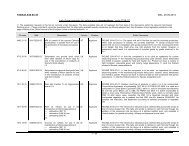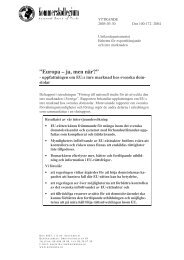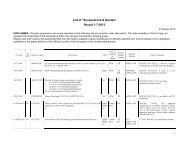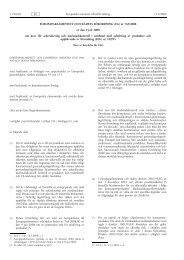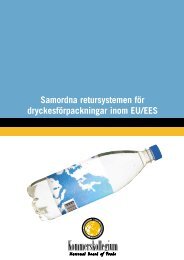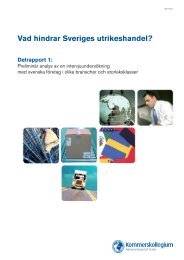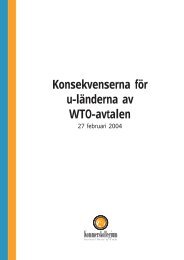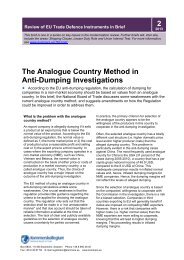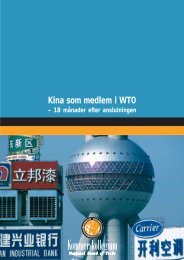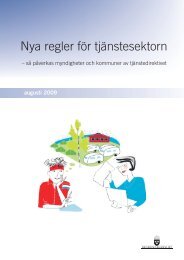Trade Facilitation - Impact and Potential Gains - Kommerskollegium
Trade Facilitation - Impact and Potential Gains - Kommerskollegium
Trade Facilitation - Impact and Potential Gains - Kommerskollegium
- No tags were found...
You also want an ePaper? Increase the reach of your titles
YUMPU automatically turns print PDFs into web optimized ePapers that Google loves.
It is essential for developing countries that their mutual Customs <strong>and</strong> tradeprocedures become much more simple, transparent <strong>and</strong> predictable at both import<strong>and</strong> export side, since 40 percent of all manufactured goods <strong>and</strong> 30 percentof all agriculture products are traded between developing countries.A more transparent system evidently creates better possibilities for fightingcorruption, which is a plague in many developing countries. Combined with thefaster <strong>and</strong> more efficient Customs procedures these measures will greatly enhancethe revenue collections at Customs, often one of the largest sources of income inmany developing countries. 345.2 TimeDelays at borders, in harbours <strong>and</strong> other checkpoints can take days, weeks <strong>and</strong>sometimes even months. It is easy to underst<strong>and</strong> that this is a burden to trade.Delayed deliveries lead to delayed payments; penalty fees; quality diminishmentof merch<strong>and</strong>ise; storage problems; <strong>and</strong> increased risk for theft – the waiting atcheck points adds massive cost to already expensive transports. Each transactionneeds time to be processed but that time can become unnecessarily long <strong>and</strong>costly due to low productivity of officials, burdensome administration,understaffing, lack of automation but also due to more deliberate delays such aslow incentives for official, bribery, unofficial governmental regulations <strong>and</strong>premeditated for other reasons.There are numerous studies showing how facilitation of Customs procedures havereduced Customs process time from days <strong>and</strong> weeks to minutes, withoutjeopardising the crime preventing role of Customs.The decrease in border delays have for a large retail company with a turnover ofaround SEK 1,300,000,000 generated the possibility of using a central warehousefor the whole Nordic market, a restructuring that annually generates anadditional SEK 1,000,000 in profit.Lengthy processing time affects not only the opportunity cost, but also the capitalst<strong>and</strong>ing of firms, this since capital bears interest <strong>and</strong> frozen capital kills otherbusiness opportunities.The loss of interest from the time of delivery, until receipt of payment, results in areduction of the exporter’s capital st<strong>and</strong>ing <strong>and</strong> vice versa for the importer’scapital st<strong>and</strong>ing with regard to time from payment to receiving the goods.The cargo release time has, after the 5-year reform of the Peruvian Customs, beenreduced from an average of 30 days to a maximum of 24 hours for green channelcargo (one or two days for goods chosen for inspection), while at the same timequadrupling the revenue collection. 35At 12 percent interest <strong>and</strong> with the value of the Peruvian import in year 2000,this would very roughly have constituted a maximum gain to the involvedcompanies of approximately US$ 71,997,000.34According to Kubota, Keiko ”Fiscal Constraints, Collection Costs, <strong>and</strong> <strong>Trade</strong> Policies:” the averageshare of import duties to the government revenue is in low income countries 25,9 percent (comparedto 0.5 percent in the OECD countries).35For more information about the reform, see: Lane, Michael H., 2000. ”International Supply ChainManagement <strong>and</strong> Customs: Peru - a Case Study.”20



